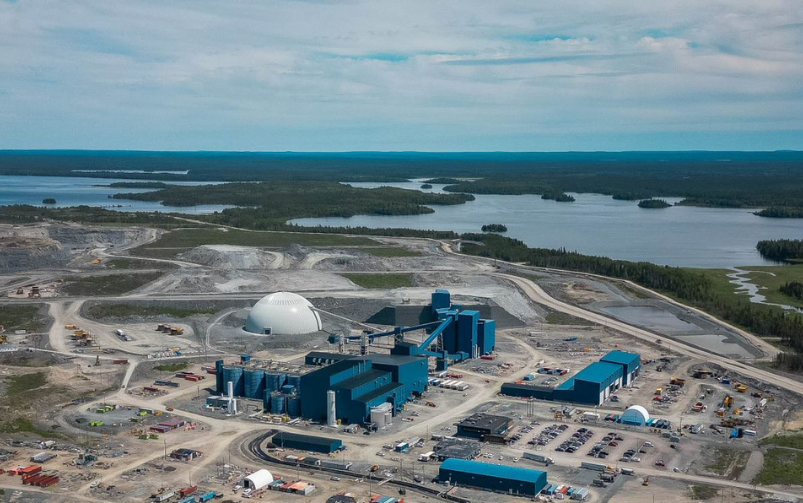Once it is completed, BHP’s Jansen project in Saskatchewan will become one of the world’s largest potash mines. Courtesy of BHP.
Welcome back to your weekly mining news recap, where we catch you up on some of the news you may have missed. This week’s headlines include developments in deep-sea mining, Teck Resources’ record quarterly copper production and Cantex Mine Development halting exploration drilling in Yukon amidst Victoria Gold incident.
has surpassed the point of construction for the first phase of its Jansen potash project, located in Saskatchewan. First production at the mine is anticipated for 2026, with an estimated output of 4.2 million tonnes of potash per year. The project, which has encountered several challenges during construction, has been recognized for its innovative approach in successfully sinking two 1,000-metre-deep shafts in October 2022.
Wildfires continue to disrupt mining operations. On July 21, following a wildfire-related evacuation order in central B.C., Artemis Gold removed nonessential workers from its Blackwater mine, which is under construction, and Osisko Development moved all non-essential and contract employees from its Cariboo gold project. The wildfire evacuation order has now been lifted and both companies have begun the return of workers to their sites, which were not directly affected by the wildfires.
Australian uranium producer Paladin Energy has listed its shares on the Toronto Stock Exchange (TSX), as reported by BNN Bloomberg. The last time a large foreign mining company joined the TSX was in 2022. Paladin struck a deal last month to acquire Fission Uranium Corp. and its uranium properties in Saskatchewan.
An employee at New Gold’s Rainy River mine, which is located in northwestern Ontario, was killed n July 24 while operating a piece of equipment in the mine’s open pit. Operations at the mine have been temporarily halted while an investigation is in progress.
Cantex Mine Development has paused exploration activities at its North Rackla lead-zinc-germanium project, which is located within the traditional territory of the First Nation of Na-Cho Nyäk Dun (FNNND) in Yukon, as reported by Canadian Mining Journal. The FNNND asked for all mining and exploration activities in the territory to be halted while it deals with the repercussions of the heap leach pad failure at Victoria Gold’s Eagle mine last month, as well as forest fires affecting its community. Last week, a mine inspector in Yukon ordered Victoria Gold to strengthen its water clean-up efforts, noting that the company’s plan to clean the cyanide-contaminated water is inadequate.
Teck Resources has reached record quarterly copper production in the second quarter, having produced 110,400 tonnes in the three months ending June 30, which is a 71 per cent increase from last year’s second quarter, as reported by The Canadian Press. The company’s Quebrada Blanca (QB) mine in Chile produced 51,300 tonnes of that total. technical issues it encountered at the QB mine during the second quarter.
First Quantum Minerals has made a three-year deal with China’s Jiangxi Copper that reduces the Chinese investor’s influence, as reported by The Globe and Mail. Jiangxi Copper, which currently has an 18.5 per cent stake in First Quantum Minerals, has agreed not to increase its stake in the company or dump a large number of shares without the miner’s permission. Commercial production at First Quantum’s Enterprise nickel mine, which is located in Zambia and is expected to become Africa’s largest nickel operation, began this week.
Canada’s The Metals Company (TMC) confirmed that before the end of 2024, it will apply for a licence that would allow it to extract minerals from the ocean floor, as reported by Reuters. This news comes during the United Nations’ International Seabed Authority’s (ISA) council and assembly meeting in Kingston, Jamaica, where the organization is attempting to finalize deep sea mining regulations. Following the publication of a paper in Nature Geoscience earlier this week positing that deep-sea nodules that TMC would potentially be mining could be producing “dark oxygen,” the company issued a statement denouncing what it calls a “flawed paper” and questioned the validity of the study’s methodology and conclusions.
Ailbhe Goodbody spoke with Anna Kaksonen, a senior principal research scientist in bio- and environmental technologies at Australia’s Commonwealth Scientific and Industrial Research Organisation (CSIRO), about biomining and the latest developments in the field for the June/July issue of CIM Magazine. Kaksonen will be presenting a keynote about the biomining of critical minerals from ores and wastes at the 25th International Biohydrometallurgy Symposium (IBS 2024) that will be held during the 63rd Annual Conference of Metallurgists (COM 2024) on Aug. 19 to 22 in Halifax, Nova Scotia.
A new book titled The Engineering Science of Mineral Processing seeks to break down the basics of mineral processing to offer readers a better understanding of the science involved in the processing of ores. A key focus of the book examines the implementation of digital twins at mineral processing plants to improve the management and efficiency of mineral processing.
That’s all for this week. If you’ve got feedback, you can always reach us at editor@cim.org. If you’ve got something to add, why not join the conversation on our Facebook, Twitter, LinkedIn or Instagram pages?




